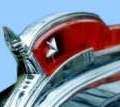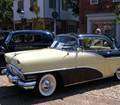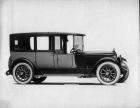|
Re: What SINGLE factor MOST contributed to the demise of Packard?
|
||||
|---|---|---|---|---|
|
Home away from home

|
So are you saying that dropping the outdated Twin-Six was the right thing to do, but dropping the outdated 384ci Custom 8 was the wrong thing?
Cadillac concluded that hydramatic provided smoothness equal to the V-16. Rolls-Royce dropped the PIII and concentrated on those hideous little Silver Dawn things that looked like a spruced up Austin 7. The plan at Packard was to keep going for volume but that changed after they fired Max Gilman. If Cadillac couldn't sell it's V-16 why would Packard prosper?
Posted on: 2013/5/7 21:47
|
|||
|
||||
|
Re: What SINGLE factor MOST contributed to the demise of Packard?
|
||||
|---|---|---|---|---|
|
Home away from home
|
IMHO:
The single most crippling bullet in the head was the death of George Mason thereby killing any sort of merger with AMC, which Mason and Nance had planned. SU8OVERDRIVES last paragraph in his post on the first page says it. The lack of amortization over several lines which allowed gm to carry Cadillac. Something that a combined AMC/Packard company could have done had it completed the proposed merger.
Posted on: 2013/5/8 8:32
|
|||
|
Al
1955 Patrician |
||||
|
||||
|
Re: What SINGLE factor MOST contributed to the demise of Packard?
|
||||
|---|---|---|---|---|
|
Home away from home

|
Merger was an option but not the only one and I would argue not the best. It's like saying that Mercedes should have merged with VW in the Fifties. A luxury car company makes a different type of car than a volume maker. Look at Lincoln today, floundering as it tries to work with volume Ford front wheel drive platforms. And every company has a personality. Packard's was completely different than Nash. Combine them and turn them both over to a professional manager and its good bye personality.
Not sure the amortization situation was as dire as most have assumed. Breakeven volumes mattered. Hudson had a breakeven of 70,000. Packard's was around 50,000 in the early Fifties. Both companies showed an ability to make a good profit, they just didn't do it consistently for reasons having nothing to do with their basic business model and everything to do with product. Yes, GM had scale. What did they spend the extra profits on? Cars of course, but also wasteful habits of the type that the old hands at Packard reamed Nance for. He thought he was a fat cat in a fat cat corporation and they tried to tell him "no, this is not how Packard has always been run". GM's spillage every day was more than the daily revenue of many small and medium sized companies. And the Caddy's greenhouse looked like a Buick. Caddy only got away with it because Packard didn't have its own act together enough to fight back. Remember the 80s commercial about the Town Car owner easily finding his car while the Caddyoldsmobuick owners were confused? On the One Twenty my point was that Packard should have immediately leveraged it like it had the 1921 Six and made a new line of Seniors so it could drop the old line after 1936. Instead they made the 115, a touchdown for the other side if ever there was one. V12s in luxury cars were of value up until high compression OHV V8s arrived, although by the mid-30s they needed to be made cost efficiently and not excessively large. 423 cubes made alongside the 282 would have been just that. And the new Senior hood would have needed to grow loooong. The company never figured out how to make a proper Senior after 1939, the exception being the '41 Sport Brougham although it meant little as an expensive custom. It and cars like it should have been mass produced the day the old Seniors were retired.
Posted on: 2013/5/8 10:46
|
|||
|
||||
|
Re: What SINGLE factor MOST contributed to the demise of Packard?
|
||||
|---|---|---|---|---|
|
Home away from home
|
I think tooling amortization was still an issue, as it lead to designs being kept in place longer than desireable in the public's eye. The larger companies used this to their advantage, being better able to afford shorter cycles. shorter cycles to amortize the tolling raises the breakeven point. remember that Packard generally wanted to be no quicker than up to date in styling. Consider this opinionated scenario:
the 1940 redesign was cautious, with the in-vogue catwalk grilles and narrower grille, but still rounded windows and heavy pillars. But attractive in a conservative way. Cadillac, LaSalle and LaSalle were perhapsd a year ahead. the 41 design alters the roofline considerably, gets the headlights in the fenders, and facilitates two tone paint. The hood line is looking dated. 41.5 Clipper with integrated from fenders and a fashioable 2 door fastback. quite up to date 46 -7 carryover 48 new body (yes , the clipper cabin damages the proportions)in modern envelope style. up to date. 1949 sales around 100,000 50 the new body now instead of 1951 54 the clever 55 facelift now 56 the planned 57 bodies so to me the 23rd series was the styling error
Posted on: 2013/5/8 11:36
|
|||
|
||||
|
Re: What SINGLE factor MOST contributed to the demise of Packard?
|
||||
|---|---|---|---|---|
|
Home away from home
|
I would have to say the twin-ultramatic transmission. I have owned a 1955 Packard since 2003 and have burned through 4 transmissions-the best one the car had was the ORIGINAL one it came with in 1955-that one lasted until june 2006 when it gave up the ghost on the PA turnpike-I have allready ordered a bendtsens tranmission conversion kit and one of thier chevy transmissions to replace the ULTRA. Simply put Ive never owned an old car that has destroyed this many transmissions.
Posted on: 2013/10/15 0:14
|
|||
|
||||
|
Re: What SINGLE factor MOST contributed to the demise of Packard?
|
||||
|---|---|---|---|---|
|
Home away from home

|
Quote:
...A luxury car company makes a different type of car than a volume maker... Paul (Mahoning63), as you know, in 1956 Packard neighter was a luxury car company nor a volume maker. Packard was in the middle of nowhere.
Posted on: 2013/10/15 18:50
|
|||
|
The story of ZIS-110, ZIS-115, ZIL-111 & Chaika GAZ-13 on www.guscha.de
|
||||
|
||||
|
Re: What SINGLE factor MOST contributed to the demise of Packard?
|
||||
|---|---|---|---|---|
|
Forum Ambassador

|
A short answer is poor management after the war by very shortsighted people.
Posted on: 2013/10/15 19:23
|
|||
|
||||
|
Re: What SINGLE factor MOST contributed to the demise of Packard?
|
||||
|---|---|---|---|---|
|
Home away from home

|
My 2 cents would have to be look at the sales numbers in the mid 1950s. GM and Ford were selling millions of cars, compared to thousands for the independents. Luxury maker Cadillac alone in 1955 sold almost as many cars as medium-priced Studebaker. The Big Three had a choke hold on television/print advertising, literally muscling out independents like Packard or Hudson, and advertising made a huge difference in sales. The independents therefore were perpetual also-rans from the early 1950s on.
Even if George Mason had lived and successfully linked Nash, Studebaker, Hudson, and Packard into American Motors, it would have still been too late to truly make any difference. The time for that merger would have made a lot more sense in the 1920s or 1930s, at the latest. Manufacturing automobiles is an expensive, high-risk business and like the law of Nature, it gets down to survival of the fittest. And Packard by 1955 was in no way very fit, especially in competition with Cadillac or Buick or Chrysler.
Posted on: 2013/10/15 19:39
|
|||
|
You can make a lot of really neat things from the parts left over after you rebuild your engine ...
|
||||
|
||||
|
Re: What SINGLE factor MOST contributed to the demise of Packard?
|
||||
|---|---|---|---|---|
|
Home away from home

|
Packard was doing fine up until the fifties. If you look at the record the lower priced 110 and 120 saved the company in the thirties, as LaSalle did Cadillac and Zephyr did for Lincoln. The prewar Clipper body looked stylish and up to date in 1947, considering everyone else reused their prewar tooling except Studebaker.
The 1948 - 1950 restyling may not seem so hot now but it was in the swim with such upside down bath tubs as the Nash, Lincoln, Kaiser and Mercury. Another thing. In the early fifties the medium price and high price class was where the action was. Buick actually outsold Plymouth in 1953 and 54. Deluxe models sold as never before. Packard should have been right in there selling like mad but they weren't. Someone else mentioned their lame advertising which was certainly a factor. Another was letting the luxury market slide in favor of the medium price models. A mistake, not only in lost sales of expensive $$$$$ profitable cars, but losing the "halo effect" of being a prestige leader. BMW and Mercedes make smaller models that are no better than a Toyota but they sell at premium prices to people who would not be seen dead in a Toyota. Packard had the same thing going for them but they threw it away. Another thing was the lack of styling changes. This was an enormous factor in selling cars in the fifties. If you didn't have an all new car at least it had to look new. Compare the 55 -56 - 57 Chevs, all built on the same body and chassis. Packard made less changes or at least less obvious changes from 51 to 54. They should have restyled the grille and tail lights every year. Or, they could have had the 55 restyle in 54 and the 56 in 55. Then an all new car. Another thing they missed out on was the trend to V8 engines. How they missed this is beyond me. Once they saw the Cadillac V8 in 1949 they should have had their own V8 no later than 51. In another thread I suggested that if they had merged with Studebaker earlier, they could have made a V12 version of the Studebaker V8 in 1952. 1 1/2 times the 232 cu in 120 HP 51 Stude would have given them a 348 cu in 180HP engine for the senior cars at minimal cost. They would have needed new tooling for block castings, heads, manifolds etc but they could have machined everything on the same transfer lines and used the same internal parts. Compare a 348 cu in 180HP Packard V12 to the 331 cu in 160HP Cadillac, 331cu in 180HP Chrysler Imperial and New Yorker, or the 317cu in 160HP Lincoln. Packard could have had a new engine at minimal cost and in a short time. The V12 with its wide power band would compliment the Ultramatic, and the 2 together would have been competitive on weight and cost. They could have had the ultimate prestige power plant for no more than their competitors were spending on their V8 engine/trans combinations. I know that Packard's sales strategy was to give their customers a real choice, not to ape Cadillac but to take a more conservative approach. In a word, they were willing to concede Broadway and Hollywood to Cadillac and take the rest of the country for themselves. This was not a bad plan. I know in many parts of the country the rich would not be seen in a Cadillac, they bought Buicks and Chryslers instead. There was a definite market for a quality car that did not suggest the owner was an Elvis fan,a gangster or a profiteer. They had a chance but they let it go. They simply did not keep up with the times. For a few years they got away with it but in the end they let their loyal customers slip away. Instead of pleasing their long time supporters, and bringing in new blood, they rested on their laurels too long.
Posted on: 2013/10/16 0:32
|
|||
|
||||








